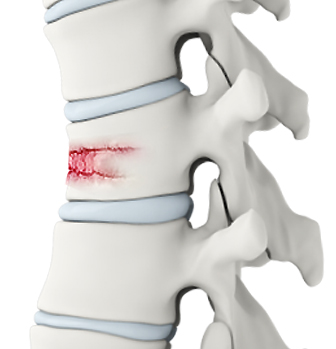
What are Fractures of the Spine?
A fracture of the spine is a break in the bone continuity of the spinal vertebrae or vertebral column. The spine extends from the neck to the lower back and consists of the vertebral bones which surround and protect the spinal cord. Damage to the spinal cord or spinal nerves can cause changes in sensation, strength, and other body functions.
Anatomy
The spine consists of 33 vertebral bones stacked one on top of the other with cushioning discs lying between each vertebra. There are 7 cervical or neck vertebrae, 12 thoracic or mid-back vertebrae, 5 lumbar or lower back vertebrae, 5 sacral bones, and 4 coccyx bones. The spine plays a key role in the smooth movement, stability, and protection of the delicate spinal cord, and gives symmetry and support to the body.
Causes
A spine fracture can cause damage to the vertebrae, disks between the vertebrae, ligaments of the spine or the spinal cord. It is often caused by:
- Motor vehicle accidents
- Falls
- High impact sports
- Shallow water diving
- Incidents of violence such as gunshot or stabbing
- Osteoporosis
Signs and Symptoms
Some of the common signs and symptoms of a spinal fracture include:
- Pressure, stiffness, and pain in the spinal area
- Tingling or numbness in the extremities
- Incoordination and weakness
- Difficulty with walking and balance
- Difficulty in breathing
- Abnormal posture of the neck or back
- Sexual dysfunction
- Abnormal reflexes or spasms
- Loss or change in sensation
- Loss of movement
- Loss of bladder or bowel control
Types of Spinal Fractures
Spinal fractures can be classified into various types based on the pattern and extent of the injury. Some of the common types of spine fractures include:
- Compression fracture: In this type of fracture, the front of the vertebra fractures and loses height; however, the back and the posterior part remains stable. Compression fractures commonly occur in patients with osteoporosis and is usually a stable fracture.
- Axial burst fracture: In this type of fracture, the vertebra loses height on both the front and backside. This fracture usually occurs as a result of a fall from a significant height. Depending on the stability of the fracture, this may require surgery.
- Chance fracture: In this fracture, the vertebra is literally pulled apart and is caused by a violent forward flexed injury. This often occurs in a car accident where the upper body is pulled forward while the pelvis is stabilized by a lap seatbelt.
- Fracture-dislocation: This type of fracture occurs due to high-energy trauma where the bone is broken and the ligaments are torn off displacing the vertebra. These fractures are usually unstable and cause serious spinal cord compression often requiring surgical correction.
Diagnosis
Your doctor will review your medical history, discuss your symptoms, and perform a thorough physical examination during which movement, muscle strength, and sensation are assessed. To investigate the spinal fracture, imaging tests such as X-rays, CT scans, or MRI scans may be ordered.
Treatment
Fractures of the spine are usually treated with braces and orthotics for 6 to 12 weeks with a gradual increase in activity. Braces and orthotics help to maintain spinal alignment, immobilize the spine during the healing process, and control pain by restricting movement.
To treat spinal fractures your doctor can perform a vertebroplasty, which involves injecting cement into the fracture site under fluoroscopic image guidance.
Articles
SpineJack: Silver Cross Now Offers Revolutionary Treatment for Osteoporosis Fractures
Nearly one million Americans suffer from extreme back pain caused by compression fractures of the vertebrae. And while the condition itself can be treated, recovery can be slow and painful.
Published on 2019





